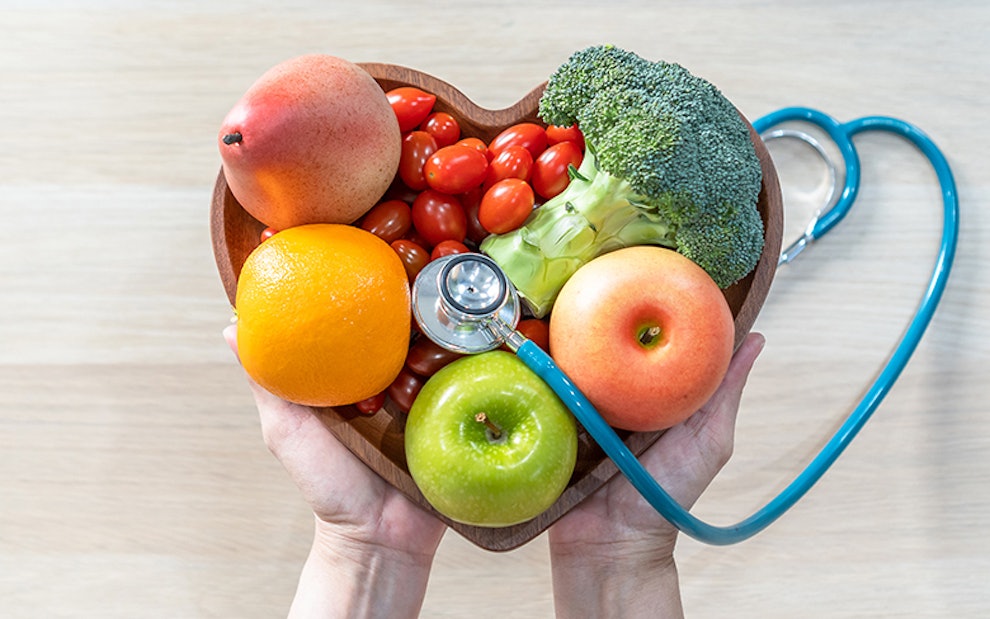Healthy Diet Tips & Benefits for Older Adults
Article at a glance
Older adults may find it more challenging to maintain a healthy diet due to changes in their bodies and lifestyle.
A healthy diet can help you live longer, become stronger, have a sharper mind, and feel better overall.
5 major food groups make up a healthy diet: fruits, vegetables, grains, protein, and dairy.
The amount of calories you should consume per day depends on your age, gender, and level of physical activity.
Many types of diets exist, but some are more beneficial than others. Learn the drawbacks and benefits before deciding which one to follow.

Good nutrition is essential, no matter how old you are. However, it’s still difficult for many people to follow a healthy diet. In fact, the average American consumes more than twice the recommended daily amount of sodium and sugar, so it’s no surprise that in the US a poor diet is considered one of the strongest risk factors for diseases that can contribute to death. Fortunately, being aware of the issue is the first step in living a healthier life. It’s important to remember that you’re in control of what you eat and what you choose to avoid.
Healthy diet overview
Eating a healthy diet helps your body get the fuel it needs to do its job. But eating healthily doesn’t always look the same for everyone. Specific dietary recommendations depend on your age, gender, and physical activity level. Compared to younger adults, older people tend to have lower calorie needs, but nutrient needs remain the same or are even greater. This can be due to decreased physical activity, slower metabolism, and age-related bone and muscle loss. As you get older, the changes in your body and lifestyle can also affect your access to nutritious food. These can include:
living alone
having trouble getting around
losing income, which may decrease your food budget
problems with chewing, swallowing or feeding yourself
taking medicines that can make your mouth dry, alter your appetite, or change how food tastes
losing your sense of taste and smell
changes in hormones that can affect how fast you feel full
Despite these issues, it’s still possible to keep a healthy diet — and it starts with knowing what it is and why it matters.
Benefits of a healthy diet
A healthy diet is important for your body to function properly, and it’s never too late to start. A nutritious diet can help you:
Become stronger: a proper diet supports your muscles, strengthens your bones, and helps you achieve or maintain a healthy weight.
Live longer: eating the right types of food can boost your immunity, and lower your risk of heart disease, type 2 diabetes, stroke, and some cancers.
Have a sharper mind: essential fatty acids found in certain types of food may help improve your focus and enhance memory.
Feel better: the right kind of food keeps your skin, teeth, and eyes healthy, and healthy eating in general can boost your energy
Knowing your food groups
Nutrient-dense foods are particularly important for older adults since small amounts can go a long way. There are five major food groups: fruits, vegetables, grains, protein, and dairy.
Fruits
Fruits can be consumed in their natural state or as 100% fruit juice. They can be fresh, canned, frozen, or dried, and can be served whole, cut, sliced, diced, or cubed. At least half of your fruit consumption should come from whole fruits, and when choosing canned forms, make sure to opt for the ones with the least amount of added sugars. Likewise, 100% fruit juice shouldn’t contain added sugars and can be also diluted with water. Nutrient-dense fruits include plain bananas, apples, and oranges.
Vegetables
Similar to fruits, vegetables take on many forms like fresh, frozen, canned or dried, and can be served cooked or raw, or even juiced (as in 100% vegetable juice). Nutrient-dense vegetables are those with little to no added salt, butter, or creamy sauces. There are four subgroups of vegetables, including:
dark green: broccoli, bok choy, kale, spinach, romaine lettuce
red and orange: carrots, bell peppers, sweet potatoes, tomatoes
starchy: corn, jicama, plantains, yam, water chestnuts
others: asparagus, cauliflower, mushrooms, beets, okra, Brussel sprouts, celery, cucumber, onions
Grains
There are two types: whole grains and refined grains. At least half of the grains you consume should be whole, and if you’re eating refined grains, opt for ones that are enriched with nutrients like folic acid. Whole grains include brown rice, barley, buckwheat, oats, quinoa, and wheat bread, while refined grains include white bread, pasta, white rice, and corn grits. Nutrient-dense grains are those with little to no added sugars, saturated fat, or salt.
Protein
Protein can come from both animal and plant sources. There are four major subgroups, including:
meat, poultry, eggs: beef, pork, chicken, turkey, lamb
seafood: sea bass, cod, salmon, tuna, oysters, crab, shrimp, squid
nuts, seeds, soy: peanuts, chia, pumpkin, sunflower, sesame, tofu, tempeh
beans, peas, lentils: black beans, chickpeas, edamame, mung beans
When choosing meats and poultry, opt for ones that are lean or low in fat, and avoid processed forms like hot dogs, sausages, and luncheon meats as much as possible.
Dairy
Dairy includes fat-free and low-fat milk (all liquid, dry, or evaporated forms), yogurt, and cheese. Those who are lactose-intolerant can choose low-lactose or lactose-free forms, and if you prefer dairy alternatives, you can opt for soy products like soy milk and soy yogurt fortified with calcium, vitamin A, and vitamin D. Cream, sour cream, cream cheese, as well as “milk” from plant products like almond, coconut, and oat, are not considered sources of dairy.
Others
Apart from the five major food groups, the 2020–2025 Dietary Guidelines for Americans also includes oils as part of a healthy eating pattern since they provide your body with essential fatty acids. Oils naturally occur in certain foods from other food groups like nuts, seeds, seafood, and avocados. Other common oils include: canola, olive, peanut, soybean, sunflower, and corn oils. As for beverages, it’s best to drink more water and nutritionally beneficial drinks like low-fat milk and 100% juice. You can also drink coffee, tea, and flavored waters, but try to avoid adding sugar and cream to keep.
How to eat healthy
The amount of calories a person should consume in a day depends on their age, gender, and level of physical activity. In general, older adults, females, and those who are less physically active require fewer calories. Adults 60 years old and over typically require between 1,600 to 2,200 calories (for females) or 2,000 to 2,600 calories (for males) a day. The Healthy US-style dietary pattern for older adults table on page 125 of the Dietary Guidelines for Americans lists the recommended daily or weekly amount of each food group and subgroup you should consume.
Because some food is denser than other and can have more air or water, a cup or ounce of one type of food may not be the same as a cup or ounce of another type of food. A “cup-equivalent” or “ounce-equivalent” measures the similar nutritional content between foods from each food group. For example:
1/2 cup-equivalent of fruit = 1 small piece of fruit (e.g., peach, plum), 1/4 cup dried fruit, 1/2 cup grapes, 1/2 cup 100% orange juice
1/2 cup-equivalent of vegetable = 1 cup uncooked spinach, 6 baby carrots, 1/2 cup broccoli florets, 1/2 large red pepper, 1/2 cup cooked kidney beans
1 ounce-equivalent of grain = 1 slice bread, 1 cup breakfast cereal, 1/2 cup cooked rice or pasta, 3 cups popcorn, 1 6‑in. corn or flour tortilla
1 ounce-equivalent of protein = 1 tbs. peanut butter, 1 egg, 1/4 cup tofu, 1/2 cup lentil soup, 1/2 ounce nuts, 2 tbs. hummus
1 cup-equivalent of dairy = 1 cup yogurt, milk, or soy milk, 1/3 cup shredded cheese, 2 cups cottage cheese
“Calories for other uses” are also included in the dietary pattern table, such as added sugars, saturated and trans fats, and alcohol. Foods under this group should be avoided as much as possible since they are not nutrient-dense and may even be harmful. You can see what’s added in the food you buy by looking at the nutrition facts label.
Different types of diets
Heart-healthy
This diet focuses on nutritional strategies that help reduce or eliminate your risk of getting heart disease by lowering your total cholesterol, “bad” cholesterol, triglycerides, blood pressure, and blood sugar level. These include:
decreasing saturated fats, trans fats, sweets, desserts, and sodas
increasing fruits, vegetables, fiber, and whole grains
substituting animal protein with plant protein
choosing low-fat or non-fat dairy
avoiding alcohol
practicing portion control
Keto
The keto diet has gained popularity over the years as a way of losing weight and lowering blood sugar levels. It requires eating a lot of fats and strictly limiting carbohydrates. Although results have been shown to appear quickly, it’s not a sustainable practice for many people. Furthermore, it can cause low blood pressure, kidney stones, constipation, nutritional deficiencies, and even an increased risk of heart disease. It’s also not safe for those who have conditions involving their pancreas, liver, thyroid, or gallbladder.
Paleolithic
The Paleo diet is based on eating food that has been around since prehistoric times — anything that can be hunted, fished, or gathered. This includes meat, fish, and certain fruits and vegetables. The Paleo diet can be potentially healthy since it’s high in fiber and antioxidants and low in simple sugars and sodium, but it deprives your body of grains and dairy, which can be part of a balanced diet. Not having enough dairy can lead to calcium and vitamin D deficiency, which increases your risk of osteoporosis. The Paleo diet also encourages intake of protein and fat beyond the recommended levels, which can be harmful to your body.
The picture of a healthy diet is different for everyone, so it’s important that you speak with your doctor or a dietitian to find out what’s best for you. A general rule of thumb is to consume nutrient-dense, low-fat foods that are prepared with little to no added sugars, refined starches, saturated fat, or salt.
Sources
https://www.heart.org/en/healthy-living/go-red-get-fit/unhealthy-foods
https://www.health.harvard.edu/blog/healthy-eating-for-older-adults-2019062016868
https://www.cdc.gov/nutrition/resources-publications/benefits-of-healthy-eating.html
https://www.helpguide.org/articles/healthy-eating/eating-well-as-you-age.htm
https://www.usda.gov/media/blog/2017/09/26/back-basics-all-about-myplate-food-groups
https://health.ucdavis.edu/welcome/features/2014–2015/06/20150603_paleo-diet.html
Become a patient
Experience the Oak Street Health difference, and see what it’s like to be treated by a care team who are experts at caring for older adults.




